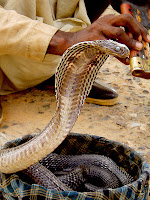
It is quite uncertain how and why it started; but it hasn’t gone unnoticed for many psychologists that most aphrodisiacs, especially from the east, are derived mostly from creatures that are either dangerous, or are so rare that it is difficult to come by. Because of these beliefs of power being drawn from the bellies of rare poisonous and fierce animals, it often lead to disastrous consequences such as lives sacrificed for obtaining such precious (and most often highly priced) elixirs, and the demise of a species hunted down to extinction. One such animal is the cobra. The more poisonous the species is, the more potent its aphrodisiac qualities. (Of course, it follows that the more powerful the effect is the more expensive, right?)
Drinking these serpents’ blood is the usual method to derive its aphrodisiac power. It is done by mixing the cobra’s blood with a strong alcoholic beverage. Most say, the alcohol serves as a neutralizer to kill the taste of the snake’s blood. Other ways include infusing a whole cobra into a jar or bottle filled with alcohol (such as whiskey, rice wine, etc) with several other herbs to add-up to the sexual revitalizing effect and left for several years or months to produce a certain aged brew that most believe would yield better results. Most often, to avoid unnecessary wastage of the animal, the body (beheaded and dripped-off of blood) is usually cooked into a tasty culinary delight. Another rare and crazier process of getting the libidinous magic out of the cobra is by mixing a pint, perhaps just a miniscule, of its venom to a an alcoholic beverage. Now that, my friend, I believe, will definitely injure if not kill you, instead of causing your snake to throb inside your pants.
There had been no scientific research conducted to provide an answer to the claims of cobra’s aphrodisiac powers but there has been an insightful thought that crossed my search for answers about this controversy:
“It is clear that the cobra toxin has a powerful effect on smooth muscle and vascular endothelium (the things that cause erections) ... initially, cobra venom has a very powerful relaxing effect (which could cause the corpus callosum to relax and trap blood in strategic reproductive areas). The initial relaxation/expansion is followed by an opposing, contracting effect.”
---aphrodisiology.com (from PubMed Reference)
Because of the “pants-tightening” characteristic of cobras most eastern nations believe in, it elevated snake farming, particularly that of cobras, to both an art and a profitable business for enterprising farmers. As with virtually all foods, a fresh product is considered best. It is common practice for some unscrupulous proprietors though to substitute other substances for cobra blood. It is probably best to insist that the blood be extracted while you watch.





















